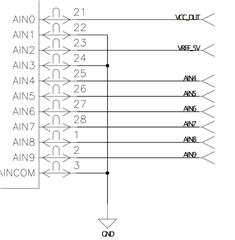Tool/software:
I am working with the ADS1263EVM-PDK Evaluation Module to assess compatibility for the ADC in a test system design. The ADC is intended to be used as an "equivalent" high-resolution DMM replacement. This system includes both differential and single ended inputs with a 0-5V range. My reference voltage comes from a 5V ultra low noise precision regulator connected on pins AIN2 and AIN3.
As far as calibration goes, its my understanding self offset calibration can be done by floating the inputs and sending the appropriate command with the PGA enabled. As far as Full-Scale System Calibration goes, what is the input voltage I should use as reference considering I will be using the ADC for both differential and single ended voltage levels? Should the PGA be enabled or disabled for this? Are there differing calibration procedures for single ended vs differential measurements or is a single calibration valid for both measurement types?
Additionally, ADC will likely be configured for varying gain settings depending on the expected input signal span. Does a calibration need to be done for each gain setting?
The SPS and filtering are fixed.
AIN4-AIN5 Differential signal
AIN6-AIN7 Differential signal
AIN8-AINCOM Single Ended
AIN9-AINCOM Single Ended



